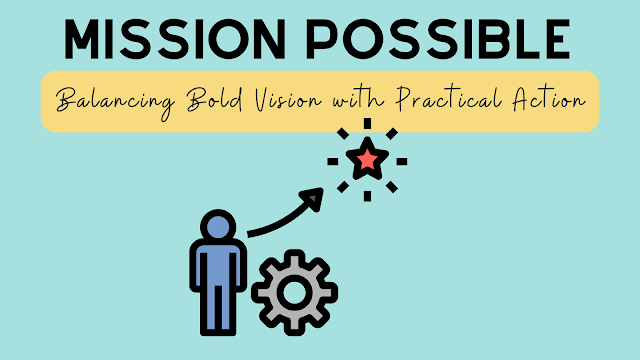Mission Possible: Balancing Bold Vision with Practical Action
The Idea: Finding the right balance between "impossible" stretch goals and "possible" achievable goals is key to achieving success in complex systems such as education. Both types of goals serve important purposes, with stretch goals providing a bold vision and inspiration, while achievable goals provide practicality and encourage action. By combining the two, you can create a dynamic that inspires innovation while also ensuring that progress is sustainable and tangible!
A few nights ago my husband and I watched a video of Tom Cruise performing another crazy stunt - he drove a bike off a cliff - for his next ‘Mission Impossible’ movie. A 60 year-old movie star who does many of his own stunts, he seems to live the ‘Mission Impossible’ philosophy.
This prompted a funny comment from my husband... "If we made a movie about you, we’d call it Mission Possible." He joked about my tendency to seek challenging but very achievable goals for my team. If it seems impossible upon thoughtful consideration, I like to rethink its priority. On the other hand, tell my husband that something is ‘Impossible’ and for him it is just fuel to pursue it with laser focus.
Which is better? Pursuing ‘Impossible’ Stretch goals or ‘Possible’ Achievable ones?
I don’t think it is a dichotomy. They are both complementary and necessary, particularly in complex systems such as Education. This is not a new idea and several books on systems or organisational change talk about the importance of this balance.
‘Impossible’ Stretch goals provide a larger vision or purpose for a team to unite around. It is courageous and inspirational. It encourages innovation and creativity. The downside is that it can sometimes be overwhelming and lead to burnout. It is hard to make progress towards the goal, tangible.
‘Possible’ Achievable goals are psychologically safe and actionable. It is practical and encourages action. It rewards regularly and intrinsically with a sense of achievement. It is sustainable but not necessarily something that inspires you to innovate or push yourself.
When Impossible Stretch goals are used together with Possible achievable goals, you embrace the ebb and flow of
Vision that inspires creativity balanced with practical action
Dreams that ignite passion balanced with steady, enduring progress
Possibility that sparks innovation grounded in realistic, sustainable change
It is seeing the forest and its trees.
It is a marathon with mile markers.
It is ‘what’ you aim to do with ‘how’ you will do it.
It is ‘thinking fast’ with ‘thinking slow’.
This probably explains why my husband and I have worked well together for 8 years without ending up divorced (lol). Our approaches are different - he is constantly pushing us to take on audacious goals and I am constantly reigning it in (sometimes because accused of being a buzz kill) while trying to figure out what it will take to implement. But we both value innovative ideas and also recognise that implementation is important because that is where many great ideas die.
Here is a visual summary of what purpose each serves while setting direction for your organisation.
This year at my school, we used the OKR (Objectives and Key Results) process to perfectly balance our stretch goals that establish direction with attainable milestone goals that allow us to monitor our progress. Despite not having started tracking yet, I'm very optimistic about the process's application in a school setting. It's been incredibly helpful in connecting our stretch goals to realistic, measurable actions and results. It has led to many strategic, collaborative conversations, but more on that in another blog later this year!
To succeed in complex systems such as education, it is crucial to strike the appropriate balance between "impossible" stretch goals and "possible" achievable goals. Stretch goals offer a big picture vision and inspiration, while achievable goals bring practicality and drive action. By combining these two types of goals, you foster a dynamic that ignites innovation while maintaining a sustainable and concrete path towards progress. Embrace this balance to turn your "mission impossible" into a "mission possible!

.png)



Comments
Post a Comment